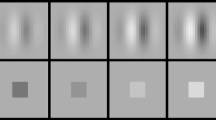Abstract
Every field of science requires standardization of metrics and measurement methods for detecting true advancement in research. Efforts on computational models of visual attention models have increased in the recent years and now it is important to have standard measuring techniques in this area in order to avoid undue deceleration in its progress. This paper performs a review of the evaluation techniques used by different researchers in the field and brings them in an organized structure. Further methods and metrics are also proposed that would lead to more objective and quantitative evaluation of the attention models.
Preview
Unable to display preview. Download preview PDF.
Similar content being viewed by others
References
Itti, L., Koch, U., Niebur, E.: A model of saliency-based visual attention for rapid scene analysis. Transactions on Pattern Analysis and Machine Intelligence 20, 1254–1259 (1998)
Peters, R.J., Iyer, A., Itti, L., Koch, C.: Components of bottom-up gaze allocation in natural images. Vision Research 45, 2397–2416 (2005)
Avraham, T., Lindenbaum, M.: Esaliency - a stochastic attention model incorporating similarity information and knowledge-based preferences. In: WRUPKV-ECCV 2006, Graz, ECCV 2006 (2006)
Baltazar, J., Pinho, P., Pereira, F.: Visual attention driven image to video transmoding. In: Picture Coding Symposium (PCS 2006), Beijing, China (2006)
Chen, L., Xie, X., Fan, X., Ma, W., Zhang, H., Zhou, H.: A visual attention model for adapting images on small displays. ACM Multimedia Systems Journal 9, 353–364 (2003)
Privitera, C.M., Stark, L.W.: Algorithms for defining visual regions-of-interest: Comparison with eye fixations. Transactions on Pattern Analysis and Machine Intelligence 9, 970–982 (2000)
Clauss, M., Bayerl, P., Neumann, H.: A statistical measure for evaluating regions-of-interest based attention algorithms. In: Rasmussen, C.E., Bülthoff, H.H., Schölkopf, B., Giese, M.A. (eds.) DAGM 2004. LNCS, vol. 3175, pp. 383–390. Springer, Heidelberg (2004)
Draper, B.A., Lionelle, A.: Evaluation of selective attention under similarity transforms. In: WAPCV 2003 (2003)
Marmitt, G., Duchowski, A.T.: Modeling visual attention in vr:measuring the accuracy of predicted scanpaths. In: EUROGRAPHICS 2002 (2002)
Meur, O.L., Callet, P.L., Barba, D., Thoreau, D.: A coherent computational approach to model bottom-up visual attention. Transactions on Pattern Analysis and Machine Intelligence 28, 802–817 (2006)
Hügli, H., Jost, T., Ouerhani, N.: Model performance for visual attention in real 3D color scenes. In: Mira, J., Álvarez, J.R. (eds.) IWINAC 2005. LNCS, vol. 3562, pp. 469–478. Springer, Heidelberg (2005)
Aziz, M.Z., Mertsching, B.: Fast and robust generation of feature maps for region-based visual attention. Transactions on Image Processing 17, 633–644 (2008)
Michalke, T., Gepperth, A., Schneider, M., Fritsch, J., Goerick, C.: Towards a human-like vision system for resource-constrained intelligent cars. In: ICVS 2007, Bielefeld University eCollections, Germany, pp. 264–275 (2004)
Hawes, N., Wyatt, J.: Towards context-sensitive visual attention. In: Second International Cognitive Vision Workshop (ICVW 2006) (2006)
Frintrop, S., Backer, G., Rome, E.: Goal-directed search with a top-down modulated computational attention system. In: Kropatsch, W.G., Sablatnig, R., Hanbury, A. (eds.) DAGM 2005. LNCS, vol. 3663, pp. 117–124. Springer, Heidelberg (2005)
Navalpakkam, V., Itti, L.: Modeling the influence of task on attention. Vision Research, 205–231 (2005)
Aziz, M.Z., Mertsching, B.: An attentional approach for perceptual grouping of spatially distributed patterns. In: Hamprecht, F.A., Schnörr, C., Jähne, B. (eds.) DAGM 2007. LNCS, vol. 4713, pp. 345–354. Springer, Heidelberg (2007)
Aziz, M.Z., Mertsching, B.: Pop-out and IOR in static scenes with region based visual attention. In: WCAA-ICVS 2007, Bielefeld - Germany, Bielefeld University eCollections (2007)
Aziz, M.Z., Mertsching, B.: Color saliency and inhibition using static and dynamic scenes in region based visual attention. In: Paletta, L., Rome, E. (eds.) WAPCV 2007. LNCS (LNAI), vol. 4840, pp. 234–250. Springer, Heidelberg (2007)
Author information
Authors and Affiliations
Editor information
Editors and Affiliations
Rights and permissions
Copyright information
© 2009 Springer-Verlag Berlin Heidelberg
About this paper
Cite this paper
Aziz, M.Z., Mertsching, B. (2009). Towards Standardization of Evaluation Metrics and Methods for Visual Attention Models. In: Paletta, L., Tsotsos, J.K. (eds) Attention in Cognitive Systems. WAPCV 2008. Lecture Notes in Computer Science(), vol 5395. Springer, Berlin, Heidelberg. https://doi.org/10.1007/978-3-642-00582-4_17
Download citation
DOI: https://doi.org/10.1007/978-3-642-00582-4_17
Publisher Name: Springer, Berlin, Heidelberg
Print ISBN: 978-3-642-00581-7
Online ISBN: 978-3-642-00582-4
eBook Packages: Computer ScienceComputer Science (R0)



